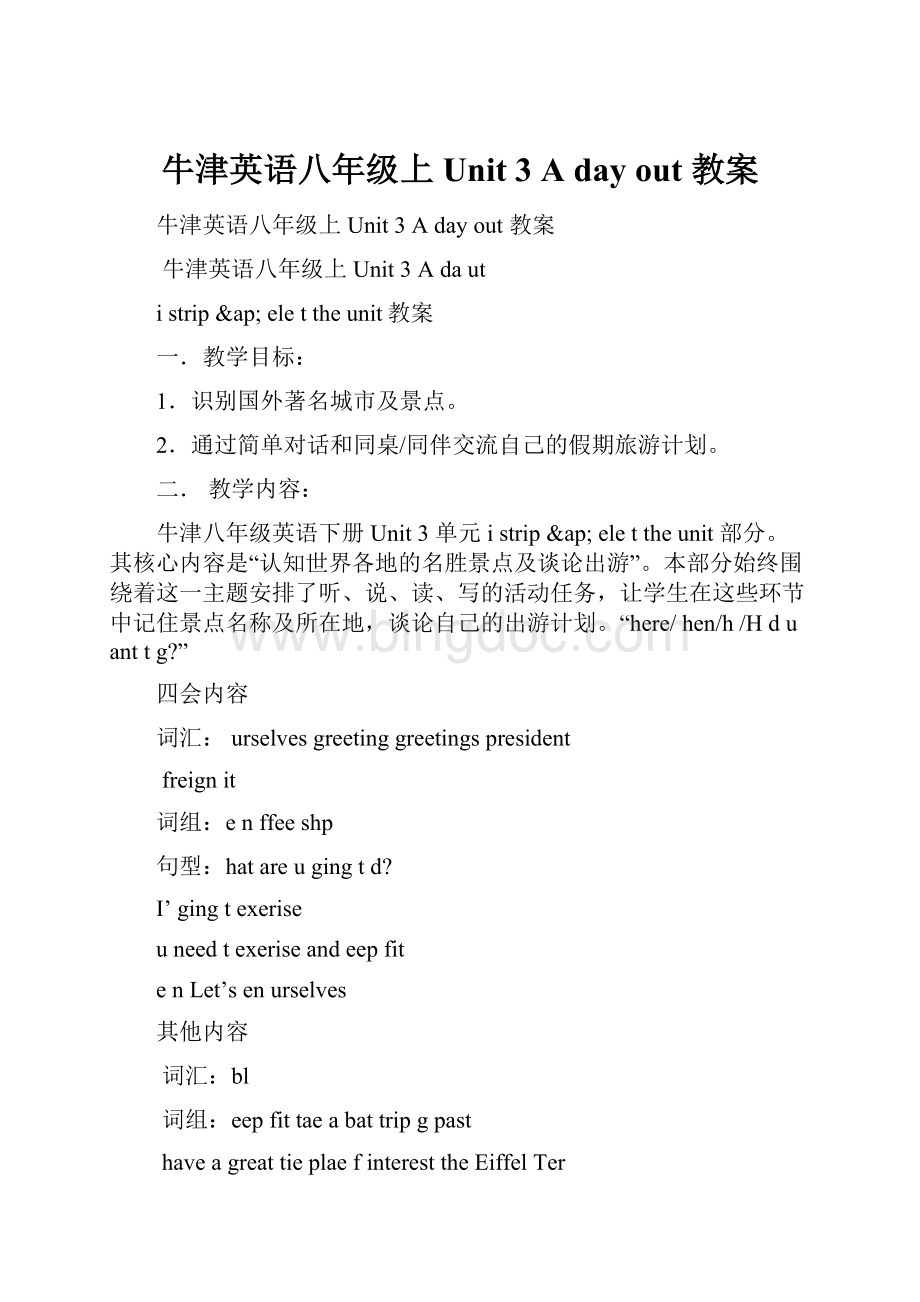牛津英语八年级上Unit 3 A day out 教案Word文档格式.docx
《牛津英语八年级上Unit 3 A day out 教案Word文档格式.docx》由会员分享,可在线阅读,更多相关《牛津英语八年级上Unit 3 A day out 教案Word文档格式.docx(18页珍藏版)》请在冰点文库上搜索。

词组:
eepfittaeabattripgpast
haveagreattieplaefinteresttheEiffelTer
thehiteHusetheRiverSeinetheperaHuse
thePraidsbtheRiverSeinetaeare
三.教学准备
1.录音机
2.多媒体
四、学情分析及教学策略
本话题自学生的生活经历,在以前的学习中,学生已经学习了许多动词短语及形容词,为表达提供了语言基础。
此外,学生已掌握了特殊疑问词here/hen/hat/h/H进行提问,为本的学习做了铺垫。
具有了学习本单元知识的认知前提,能自然的与本单元的话题衔接。
本部分内容贴近生活,学生比较容易进入角色。
因而,教师在堂中应通过场景图片促使学生积极地参与,在任务型教学活动中,使学生有话想说,有话可说,在完成各项任务的过程中自主学习语言,提高他们综合运用语言的能力,学会更好地与他人沟通。
使各层次的学生都有所收获。
五.教学步骤:
Step1呈现
1向学生提问:
Ifuarefree,hatareugingtd?
帮助学生练习I’gingt…待学生回答后问:
hatduthinEddieisgingtdifheisfree?
鼓励学生大胆猜测。
然后教师为学生播放istrip部分的录音,要求学生带着问题听录音并回答:
Heisgingtexerise
2学生看图并阅读Eddie和Hb的对话。
然后教师针对对话内容提问:
IsEddiereallgingtlibthehill?
hatishereallanttd?
Step2表演
1学生两人一组互相交换角色表演对话,鼓励学生根据自己的想象添加内容。
2请几对学生上台表演,并给予鼓励和表扬。
Step3呈现
1.呈现中国长城、美国白宫、法国艾菲尔铁塔、悉尼歌剧院、悉尼港湾大桥、意大利比萨斜塔等世界名胜古迹,和学生一起了解它们uhaveseenanplaesfinterestintherldDunthenaesfthesefausbuildings?
引导学生回答问题,同时将这些名胜的答案写在黑板上并带领学生朗读,确保他们能掌握其发音。
2.呈现一些名胜及其所属的城市及国家名称,要求学生对应连接,使学生对此有更深的了解。
呈现本第39页A部分明信片中提到的一些名胜,并对应给出几个问题,要求学生阅读,给出问题答案。
Step4呈现
1.教师通过语言为学生创设情境:
Afterreadingthepstards,SinisdisussingithAabuthihfreignuntrheantstvisithihuntrdesheanttgt?
教师播放本第39页B部分的录音,学生听完一遍后回答:
HeantstgttheUSA
2.教师接着与学生进行交流,并让学生带着问题听录音:
hihitdesheanttvisit?
hdesSinanttgthere?
分角色朗读。
Step练习
1.让学生两人一组按要求做对话替换练习。
2.做针对重点的翻译练习。
3.口头作,介绍自己的出行计划。
Step6家庭作业:
1.熟读内容。
2.将堂口头作写下。
3.完成《补充习题》相关练习。
牛津英语八年级上Unit3AdautReading教案
一.教学目标
1.读懂,了解此次游玩的基本情况
2.复习和拓展有关世界名胜的知识。
3.学会用正确的形容词描述旅游的感受。
二.教学内容
四会内容
beginningahtraffis
deletalinsidehleinterest
realsngInternetainstah
invite…t…atthebeginning
getnaahaltftraffi
feelsibeadefetal
plaesfinterestinin
句型:
Thetripfritt’sshltabutthursbah
ittandIdidntfeelsianre
ThedelpraidsledustlietherealnesinEgpt
henIsathe,Iuldn’tbelieveees
itt’slassateDanieltaughthiselfhtaeahepage
Heputhisphtsnitfrevernetlat
highapraidparade
veent
nthehighantanre
enneselfthehlerld
frallvertherldntheInternet
hepage
三.背景知识
此部分向学生介绍私人信的书写方式,信中用非正式的语言描述了Linda去北京世界公园旅游的一次经历,并表达了旅游之后的感受。
四.教学准备
1.教学图片。
2.多媒体或投影仪。
3.录音机。
五.教学步骤
Step1呈现
1教师就出游计划向学生提问:
(1)hereareugingduringthehlida?
(2)hihitareugingt?
(3)hduanttgthere?
(4)Hduplantgetthere?
鼓励学生发表自己的观点,同时复习前一所学内容。
2呈现几幅世界名胜古迹图片,询问学生:
(1)Haveueverbeentfreignuntries?
(2)Duntheseplaesfinterestintherld?
hatarethe?
(3)anutravelarundtherldtseeahundredplaesfinterestfrallver
therldinada?
接着教师向学生介绍自己的计划:
I’dlietgttherldParinBeiingThere
aredelsfverahundredplaesfinterestfrallvertherldeansee
theEiffelTer,thepraidsandtheGldenGateBridgeintheparThel
ustlietherealnesSIantravelarundtherldinadahatanaazingda
itillbe!
教师将重点词汇呈现在黑板上,并带领学生朗读,确保学生掌握发音
和含义。
Step2阅读
1向学生介绍:
LindaentttherldParinBeiingiththelass1,Grade8
studentsShertealetterthertherDuanttnhatshedidand
hatshesathere?
通过提问激发学生的好奇心和求知欲。
2呈现六个问题,让学生带着这些问题听录音,然后给出答案。
(1)heredidLindag?
(SheentttherldPar)
(2)hdidshegith?
(itt,ruandtherstudents)(3)Hdidshegthere?
(Bah)
(4)hatdidshesee?
(anplaesfinterestfrallvertherld)
()Hdidshefeelatthebeginning?
Andhatabutatlast?
(It’sbring;
feelsifrstfthetripFeelhappandexitedfinall)
3教师解释中的重点、难点内容。
ahnabus(usuallithasingledes)frarringpassengersverlngdistanes(长途汽车)bah
highan(espeiallUS)aainradbeteenities(城镇间的公路)
nthehigha
tripn(travelfrneplaetanther)
taea(shl)tripts/gnatript/travelts/gtravelling
traffinvehilesvingalngaradrastreet(不可数)交通,运输,交通量traffia交通堵塞
interestn令人感兴趣的事或人;
兴趣爱好;
利息aplaefinterest
paradenapublipressin(庆祝)游行snganddaneparade
beginvbeginningnatthebeginningf在…的开始
4教师给出一些单词、短语及其释义,让学生根据理解对应连接。
ahntinteresting
bringabusfrtaingpeplenlngtrips
altftraffintfeelell
highaintheend
feelsiaainradbeteenities
atthebeginning(反)ltsfars,buses,andtrusnrads
(1)ItthalfanhurtgetttherldParfrshlF
(2)eentttherldParbahfrSunshineTnF
(3)eseethedelpraidsfrtheahF
(4)TherearedelsfanplaesfinterestthereT
()ThedelpraidsledustlietherealnesintheUSAF
(6)ThedelEiffelTerisatallstnebuildingF
(7)DanieladeaspeialhepagefrthetripF
成五大组,呈现表格,给每组的各个学生安排一个部分,让他们寻找描述Linda当天在不同地点所见到的人或物及不同阶段感受的形容词。
(2)Linda’sfeeling:
Atthebeginning:
Bred;
si
Atthegateftherldpar:
exitedIntheend:
aazed
Step3练习
1教师呈现Linda行程中的三个主要地点及其感受,让学生根据对的理解对应连线。
,
(1)Atthebeginningfthetrip,Asheuldn’tbelieveherees,shethught
theparisnderful
(2)henshearrivedatthepar,BLindadidn’tenitandshefeltsi
(3)hensheasinsidethepar,shebeaeexited,shedidn’tfeelsianre,sheantedtenherself
2教师呈现六个打乱顺序的中不同场景的图片和字说明,让学生排序,
进一步加深他们对的印象。
Aesadelsfanplaesfinterestfrallvertherld
BThetripasbringittandLindafeltsifrstfthetrip
eallgtfftheahquil
Deetitt’susinLinda
EesathedelEiffelTerfrurah
FThereasasnganddaneparade
Iasverhappthatdabeauseteaherru______usinLindat_____inurshltripAtthe______edidn’t_____itbeausethereasheav_____intheradLindaandIfelt____frstfthetripFinalle_____attherldParhenesatheEiffelTer,LindaandIbeae_____IntherldPar,thereereverahundredplaesf_____frallvertherldThebestpartasthesnganddane_____Ireallened_____nthat______daAfterurtrip,Danieltaught_____htaeahepageHeputhisphtsnit(答案:
Invited/in/beginning/en/traffi/si/arrived/exited/interest/parade/self/aazing/hiself)
Attheshlgate,…invited…t…,agreatdabut…atthebeginning
et/gtn/t2hurs/bring
ntheitrads,heavtraffi/felt……nthehigha,thetraffigt……AtthegateftherldPar,s/esa/beae/gtff/ntsianre/anted…/en…Insidethepar,thehlerld…/ver…plaesfinterest…/praids/bridge/ntbelieveee/best
4教师让学生仿照谈谈自己难忘的一次旅行经历。
Step4家庭作业
1背诵本单词及重要的词组和句子。
2熟读。
3完成《补充习题》及《伴你学》上的相关练习。
4预习Vabular
牛津英语八年级上Unit3Adaut
Vabular教案
1.识别北京的著名景点。
2.学会使用适当的词语谈论交通方式。
beaut
Tian’anenSquaretravelbundergrund
rideabile
其它内容
vie
LasheTeaHusetheSuerPalae
thePalaeuseuangfuingStreet
多媒体
四.背景知识
本部分介绍了北京的一些名胜以及在那里可以进行的活动。
中还介绍了到达北京名胜的交通方式。
1提供一组北京名胜的图片,通过与学生讨论图片的内容,呈现北京著名景点及名胜的名称。
例如,教师呈现一张老舍茶馆的图片,并介绍说:
L,dunhereitis?
es,itisLasheTeaHusehatanedthere?
eandrinspeialteaandennderfulBeiingperainit接着老师展现一张颐和园的图片,说:
hatanedthere?
eanenthebeautftheldparthere
2教师带领学生朗读这些词汇,确保他们能掌握其发音。
Step2练习
1.要求学生正确匹配场所及活动内容。
2.教师向一位学生提问:
hereduanttgst?
hduanttgthere?
Hduanttgthere?
要求学生根据实际情况谈谈自己的想法,从而巩固所学知识。
3.呈现一些交通工具,要求学生根据对北京的了解,选择合适的方式完成句子。
Step3呈现及练习
呈现江苏省省会南京的一些名胜,教会学生这些地点的名称,并要求学生用所学的词汇填空。
Step4练习
1.区分表示交通方式的动词与介词练习。
2.各种介词填空练习。
Step家庭作业
1TrtgetreinfratinabutBeiingfrtheInternet
2Reitethenephrases
3Previethenelessn
GraarA&
B教案
1.学会使用and,but和r将意思连接起。
2.正确使用不定式。
3.掌握反身代词的用法。
sunsetpssibletheselvesitselfr
nderliberluillu
ghrseridingplanttaeLindaut
agreetgiththedeidetstaathe
pulltheselvesupthers
Thanufragreeingtletegnthetrip
Ihpetaththesunset
hide-and-see
thebustraffitheelluntain
athristas
本部分继续讲述旅游参观以及决定去拿些景点的主题,鼓励学生表达自己的观点,并对不同景点的特别之处做出评价。
语法练习的三个部分密切相连,按故事发展顺序分别呈现不同内容,因而要让学生在做语法练习前将故事作为一个整体理解,这一点很重要。
A部分通过谈论学生可能去旅游的地方,介绍了and,but和r的用法,学生有机会就游览时喜欢什么发表自己的看法。
B部分在关于去SuthHill郊游的对话中,介绍了带t的不定式的用法。
部分是一个漫画故事,讲述了去SuthHill游览的过程中发生的一事,在此语境中让学生注意反身代词的用法。
五.教学步骤
1教师通过以下练习,检查学生对的记忆及掌握情况。
(1)Thes____(be)blueandeverthing____(be)beautiful
(2)It____(be)agreatdabute_________(nten)itatthebeginning
(3)Linda’stheran____(l)atLinda’sphtsnDaniel’shepagerLindaanshhertherherphtshenshe____(g)he
2.教师呈现与前相关的、使用and,but和r的几个句子,在比较与讲解中,使学生了解这几个连词的用法。
ThesisblueEverthingisbeautiful
ThesisblueandeverthingisbeautifulTheGldenGateBridgeisinterestingTheGldenGateBridgeisnderful
TheGldenGateBridgeisinterestingandnderfulThepraidsaresallearelingfrardtvisitingit
Thepraidsaresallbutearelingfrardtvisitingit
ThepraidsaresallThepraidslustlietherealnes
Thepraidsaresallbutlustlietherealnes
IillvisitParisbselftherillshearundParis
IillvisitParisbselfrtherillshearundParis
IillgtFranebplaneIillgtFranebtrain
IillgtFranebplanerbtrain
4.教师让学生根据以上各句的内在关系,讨论并猜测这三个连词的用法。
教师最后总结。
(1)and:
tinideasthataresiilarhenthetsubetsarethesae,eusuallitthesendne
1教师准备更多的“and/but/r”练习加深理解。
2让学生看本第46页和47页的练习,先带领学生完成两个小题。
然后分别请五位同学口头完成其他五个小题。
集体朗读。
Step3呈现
1教师结合前面所学过的名胜古迹,询问学生是否想外出旅行,引导学生讨论在准备外出旅行时可能会考虑的一些问题。
例如:
(1)hereduanttvisit?
(2)hduplanttaeut?
(3)hatduantttae?
(4)Hdudeidetgut?
()hatduhpetdthere?
1)eanuseverb